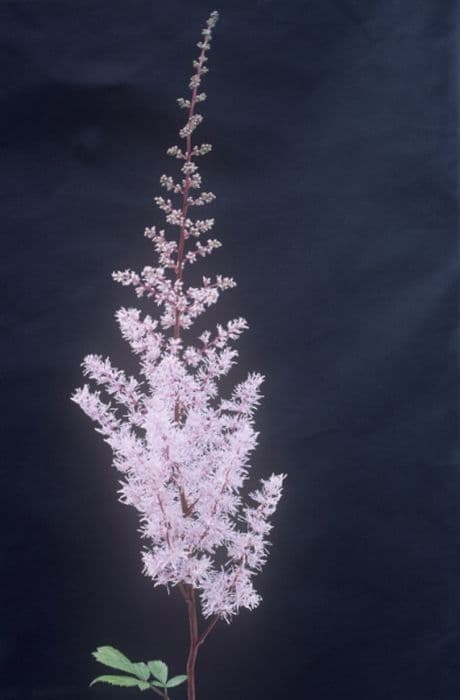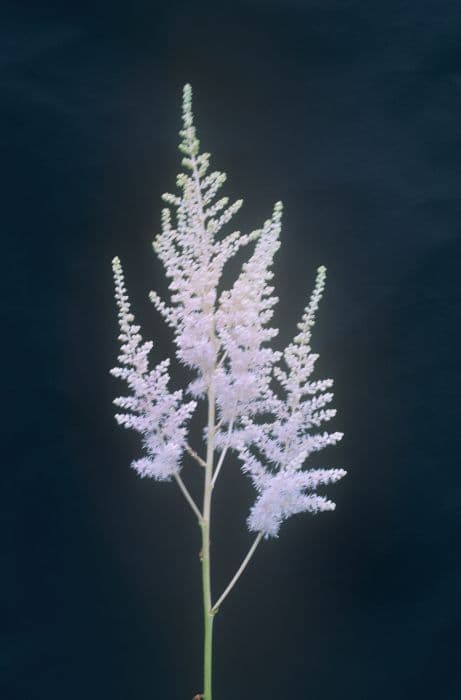False goat's beard Astilbe 'Brautschleier' (× arendsii)

ABOUT
Astilbe 'Brautschleier' is a charming perennial known for its graceful and feathery plumes. The soft, fluffy flower spikes boast a creamy white color and are held aloft lush, fern-like, deep green foliage. The leaves are deeply divided, creating an intricate and delicate texture that contrasts beautifully with the airy flower clusters. These blooms typically appear in mid to late summer, creating a light and ethereal display in a garden landscape. The plant has a bushy, clumping habit, and the flowers are often used for adding a light, bright touch to shady garden areas or for creating romantic flower arrangements.
About this plant
 Names
NamesFamily
Saxifragaceae
Synonyms
False Goat's Beard, False Spirea
Common names
Astilbe × arendsii 'Brautschleier'.
 Toxicity
ToxicityTo humans
The False Spirea is not known to be toxic to humans. Therefore, ingestion of this plant typically does not lead to poisoning or adverse health effects. However, as with any plant material, individual sensitivities can vary, and ingesting plant matter could potentially cause mild stomach upset or an allergic reaction in sensitive individuals.
To pets
The False Spirea is considered non-toxic to pets such as dogs and cats. It is not expected to cause any symptoms of poisoning if ingested by pets. However, ingestion of non-food items can sometimes result in gastrointestinal discomfort or an upset stomach in some animals. Owners should still prevent pets from consuming plants as a precautionary measure.
 Characteristics
CharacteristicsLife cycle
Perennials
Foliage type
Deciduous
Color of leaves
Green
Flower color
White
Height
2 feet (60 cm)
Spread
2 feet (60 cm)
Plant type
Herb
Hardiness zones
4
Native area
Asia Europe
Benefits
 General Benefits
General Benefits- Attracts pollinators: Astilbe 'Brautschleier' or False Spirea is beneficial for attracting bees and butterflies, promoting pollination in the garden.
- Low maintenance: This plant requires minimal care once established, making it an easy choice for busy gardeners.
- Shade tolerant: It thrives in shady areas where other plants might not grow, providing color and texture to dim garden spots.
- Drought resistant: Once established, Astilbe 'Brautschleier' can tolerate periods of dryness, though it prefers moist conditions.
- Dramatic foliage: The plant offers deeply lobed, fern-like foliage that adds a lush backdrop to garden beds or borders.
- Long blooming: It features long-lasting, feathery plumes of flowers that bloom in late spring to midsummer, extending the garden's visual interest.
- Color variety: The plant offers a range of colors through its flowers, contributing to a diverse garden palette.
- Erosion control: Its dense growth can help prevent soil erosion in sloped or delicate areas of the landscape.
- Seasonal interest: In fall, the foliage and seed heads of False Spirea can provide autumnal interest in the garden.
 Medical Properties
Medical PropertiesThis plant is not used for medical purposes.
 Air-purifying Qualities
Air-purifying QualitiesThis plant is not specifically known for air purifying qualities.
 Other Uses
Other Uses- Photography Prop: Astilbe provides a feathery, textured backdrop for close-up photography of insects or other garden features.
- Educational Tool: Botany enthusiasts or educators can use Astilbe to demonstrate plant structure and pollination strategies to students.
- Art Supplies: Petals and leaves of the Astilbe can be used to create natural dyes for fabrics or inks for painting.
- Crafts: Dried Astilbe flowers can be incorporated into homemade paper or potpourri mixtures for a touch of natural beauty and scent.
- Fish Tanks: Aquarists sometimes use dried Astilbe stems as organic, biodegradable decorations in aquariums.
- Sound Insulation: The fibrous material of Astilbe can be tested as a natural sound insulating material for eco-conscious building projects.
- Erosion Control: Astilbe’s dense root system can help stabilize soil and prevent erosion on slopes or banks in gardens.
- Culinary Garnish: Although not commonly consumed, the bright blooms can serve as an edible garnish for salads or desserts after ensuring they are free from pesticides.
- Event Decor: Branches of Astilbe can be used as part of natural, rustic decorations for weddings or other events.
- Ice Preservation: Delicate Astilbe flowers can be frozen into ice cubes to add an aesthetic touch to summer drinks or punch bowls.
Interesting Facts
 Feng Shui
Feng ShuiThe Astilbe is not used in Feng Shui practice.
 Zodiac Sign Compitability
Zodiac Sign CompitabilityThe Astilbe is not used in astrology practice.
 Plant Symbolism
Plant Symbolism- Patience: The astilbe plant takes time to grow and flourish, symbolizing the virtue of patience and the rewards that come with waiting for the right moment.
- Endurance: Astilbe is known for its hardiness and ability to thrive in shade, representing endurance and the ability to persevere through challenging conditions.
- Love and Affection: With its delicate and feathery plumes, astilbe is often associated with romantic feelings, symbolizing love and affection in a gentle and subtle manner.
- Devotion: Often found in wedding bouquets and arrangements, astilbe symbolizes devotion and commitment, reflective of the plant's loyal blooming year after year.
- Illumination: The brightness of the astilbe flowers amidst darker, shaded garden areas symbolizes illumination, bringing light and positivity to one's life.
 Water
WaterFalse Spirea should be maintained with evenly moist soil, so it's essential to water it regularly, about once or twice a week, but this can vary depending on weather conditions like heat and drought. During hot spells, it may require watering every couple of days. Generally, give the plant about 1 gallon of water per week, ensuring you adjust the amount during rainfall to prevent overwatering. Always check the top inch of soil for dryness and water when it feels dry to the touch to keep the Astilbe hydrated without causing water-logging.
 Light
LightFalse Spirea thrives in partial shade to full shade, where it is protected from the harsh afternoon sunlight. The ideal spot for this plant is an area that receives filtered sunlight or morning sun with afternoon shade, as too much direct sun can scorch the delicate foliage.
 Temperature
TemperatureFalse Spirea prefers temperate conditions and is hardy in zones 4 through 8, suggesting it can withstand minimum winter temperatures down to -30 degrees Fahrenheit. Ideally, the plant flourishes in temperatures ranging between 65 and 75 degrees Fahrenheit. It's crucial to protect the plant from extreme heat, as temperatures consistently above 80 degrees Fahrenheit can stress it.
 Pruning
PruningFalse Spirea requires minimal pruning, more for aesthetic reasons or to remove spent flowers which can encourage a second bloom. Pruning should be done in late winter or early spring before new growth starts. Cut back the dead flower stalks and remove any damaged or dead foliage to maintain the plant's shape and health.
 Cleaning
CleaningAs needed
 Soil
SoilFalse Spirea thrives in rich, moist, well-draining soil with a pH range of 6.0 to 8.0. The best soil mix is one part garden soil, one part peat moss, and one part perlite or coarse sand to ensure good drainage. Adding organic matter such as compost will provide nutrients and enhance soil structure.
 Repotting
RepottingFalse Spirea should be repotted every 2 to 3 years or when it outgrows its container. It's best to repot in the spring before the growing season starts. If the plant is not growing vigorously or seems pot-bound, check the roots and repot into a slightly larger container with fresh soil.
 Humidity & Misting
Humidity & MistingFalse Spirea prefers high humidity environments. The best humidity level for this plant would be between 60% and 80%. Mist the leaves regularly or use a humidifier to maintain adequate humidity levels, especially during dry seasons or in indoor heating environments.
 Suitable locations
Suitable locationsIndoor
Choose a location with bright indirect light and keep soil moist.
Outdoor
Plant in partial shade and keep soil consistently moist.
Hardiness zone
4-8 USDA
 Life cycle
Life cycleAstilbe 'Brautschleier', commonly known as False Goat's Beard or False Spirea, begins its life cycle as a dormant rhizome planted in early spring or fall. It then sprouts fern-like foliage and establishes a robust root system. In late spring to early summer, the plant sends up flowering stalks that bloom with feathery plumes of tiny white flowers. After the flowering period, the blooms fade and seed heads may form, although astilbe is more commonly propagated by division of rhizomes. As temperatures drop in autumn, the plant's foliage will die back and it enters a period of winter dormancy. The lifecycle restarts in the following spring when new growth emerges once again from the rhizome.
 Propogation
PropogationPropogation time
Spring to Summer
Propogation: Astilbe 'Brautschleier', commonly known as false spirea, is most effectively propagated through division. The best time to propagate is in the spring or early fall when the plant is not in bloom. To propagate by division, carefully dig up the plant and gently separate the clumps into smaller sections, ensuring that each section has several growing points or shoots. These divisions can then be replanted in the garden at the same depth they were originally growing, spacing them about 18 to 24 inches (45 to 60 centimeters) apart to allow sufficient room for growth. Water the new divisions thoroughly after planting to help establish the roots in their new location. This method of propagation is quite simple and enables gardeners to quickly expand their collection of false spirea or share with fellow plant enthusiasts.









